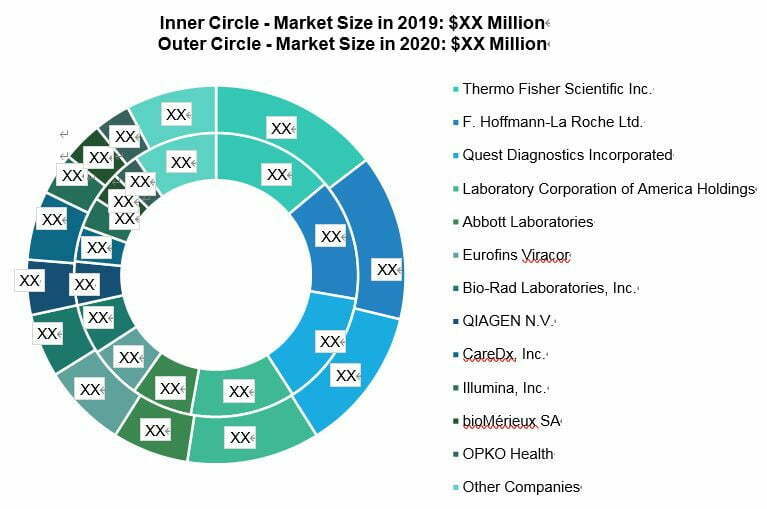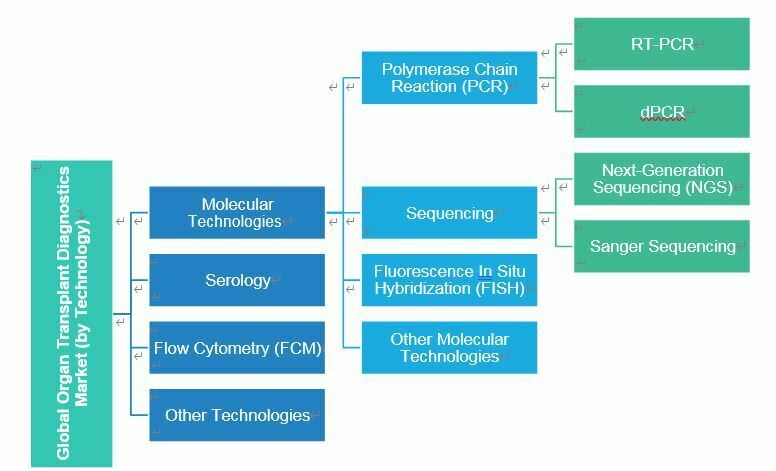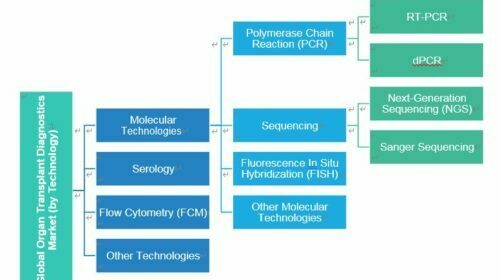Organ Transplant Diagnostics Application & Tech Overview
Executive Summary
Organ transplantation is one of the most preferred treatment options for patients suffering from end-stage chronic diseases, which further leads to organ dysfunction. Organ transplant diagnostics has become an integral component for conducting clinical assessments of various attributes associated with donor organ’s screening and recipient surveillance. The increase in the healthcare burden due to the growing number of chronic conditions coupled with the rising awareness among patients regarding the clinical outcomes associated with organ transplants has led to the development of high-fidelity transplant diagnostic approaches which could offer long-time survival. As organ donor and recipient screening are mandatory, emerging and established companies operating in the market are massively invest in the development of products and services based on cutting-edge technologies. Additionally, advancing molecular assay technologies harnessing increasing knowledge of transplant-associated biomarkers are now on the verge of revolutionizing approaches to healthcare and medicine worldwide. Innovations such as next-generation sequencing (NGS) and polymerase chain reaction (PCR) enable accurate quantification and analysis of transplant-associated biomarkers, which are difficult to be identified and measured using conventional serology-based methodologies. Therefore, manufacturers and service providers operating in the organ transplant diagnostics landscape are massively investing in research and development (R&D) to develop and expand their respective portfolios, which is expected to offer better clinical outcomes. As the next frontier of precision medicine, the global organ transplant diagnostics market showcases enormous potential to completely revolutionize the field of transplant care worldwide.
Growth in this market is expected to be driven by the rising number of organ transplant procedure, strategic initiatives by key market players, and favorable regulatory scenarios. However, factors such as the high cost of organ transplant and transplant diagnostics products and lack of knowledge dissemination, and reluctance toward organ transplants are some of the significant challenges restraining the growth of the global organ transplant diagnostics market.
In 2020, the global organ transplant diagnostics market (by application) was dominated by recipient testing, which held a share of XX%. This trend is expected to continue during the forecast period 2021-2031, with the segment anticipated to hold a XX% share in 2031. This is primarily due to the growing emphasis on post- transplant surveillance coupled with the increasing cases of opportunistic infectious disease manifestation due to the administration of a high dosage of immunosuppressant therapies. However, the donor testing segment is anticipated to witness the highest growth of XX% during the forecast period, 2021-2031. This is majorly due to the presence of robust guidelines pertaining to organ donor screening, rising focus on donor-derived organ quality, and growing investments by the companies for the development of organ donor screening products, among others.
COVID-19 Impact on the Global Organ Transplant Diagnostics Market
The current global organ transplant diagnostics market study comprises products and services that are utilized to conduct organ donor and transplant recipient testing. Since the market is primarily dominated by the clinical utility of products and services, the COVID-19 pandemic had a massive impact on the growth of revenue generated from the market. The current market assessment has considered information provided by key opinion leaders in the market from both supply and demand sides. Although manufacturers have witnessed low-scale losses due to decreased demand, the losses incurred for the first two-quarters of FY2020-2021 are anticipated to be compensated by higher demands in the following two quarters. However, the industry is still expected to be impacted significantly during the period 2020-2022.
Competitive Landscape
The global organ transplant diagnostics market is currently witnessing several strategic developments, primarily aimed toward bringing new products and services to support transplant physicians to offer better transplant outcomes. The establishment of the role of organ transplant diagnostics for donor and recipient testing, along with the growing awareness about the clinical advantages associated with organ transplants, have supported the companies to invest significantly in new product developments. Major manufacturers and service providers involved in the development and commercialization of organ transplant diagnostics tests are actively involved in undertaking significant business strategies in order to achieve success in the commercial clinical setting.
With the ever-expanding knowledge being extracted from innovative organ transplant research and revelations regarding its impactful role in offering a better clinical outcome, manufacturers and service providers in the global organ transplant diagnostics market are actively investing in developing organ transplant testing solutions to detect the presence of transplant-associated infectious pathogens and biomarkers. Rapid technological developments and their simultaneous adoption among major companies have made the global organ transplant diagnostics market one of the most lucrative opportunities for major companies within the entire molecular diagnostics biosphere, as many companies are focusing on developing robust products and services for different applications, particularly focusing on organ donor screening and post-transplant recipient surveillance. With both market juggernauts as well as emerging, disruptive companies playing a highly significant role in the market, this industry is rapidly evolving to regularize transplant care in clinical settings.
Market Share Analysis for Global Organ Trans plant Diagnostics Market, $ Million, 2019 and 2020

The global organ transplant diagnostics market has been dominated significantly by companies such as Thermo Fisher Scientific Inc., F. Hoffmann-La Roche Ltd., and Quest Diagnostics Incorporated, owing to their expansive product and service portfolios. However, due to emerging industry-academia collaborations and the increasing influx of funds into smaller companies, the market is extremely dynamic. The market is witnessing the emergence of a huge number of smaller companies and larger companies adopting strategic measures to establish their dominance.
Application – Diagnostics & Translational Research
Various advancements in the diagnostics industry, including the advent of molecular assay technologies, have significantly enabled extensive research, thereby resulting in the discovery of potential applications pertaining to the organ transplant diagnostics ecosystem. Currently, research studies examining transplant-associated biomarkers coupled with the development of high-fidelity organ transplant diagnostic products and services are playing an unprecedented role by offering high-quality results in the field of transplant medicine. The rapid expansion of technological expertise in the organ transplant diagnostics landscape has led to the development of applications catering to the attributes associated with transplant care in clinical settings. The organ transplant diagnostics market offers immense opportunities to utilize advanced diagnostic techniques for addressing specific needs associated with organ transplants.
The global organ transplant diagnostics market (by application) is broadly segmented into diagnostics and translational research. The global organ transplant diagnostics market (by application) was dominated by the diagnostics segment, which held a massive share of XX% in 2020. This trend is expected to continue during the forecast period, 2021-2031, with the diagnostics segment anticipated to hold a XX% share in 2031. The high share of the segment is attributed to the growing focus on the incorporation of advanced organ transplant diagnostics solutions in the clinical settings, growing emphasis on long-term value-based care, rising focus on organ donor screening, growing focus on new product development, significantly growing number of organ transplants worldwide, and rising adoption of precision diagnostics, among others. However, the translational research segment is expected to witness the highest CAGR of XX% in the global organ transplant diagnostics market during the forecast period 2021-2031.
The global organ transplant diagnostics market is primarily a diagnostic-based market, wherein major players manufacture products for use in clinical settings all around the world. These include diagnostic utilities in organ donor and recipient testing for a wide array of applications which include infectious disease diagnosis, human leukocyte antigen (HLA) typing, ABO blood grouping, chimerism testing, and graft versus host disease (GvHD) screening, among others. It is worth mentioning here that chimerism testing and GvHD screening are only conducted in stem cell transplant patients to eliminate future medical complications.
Technology Overview
Although well-established technologies such as serology are being used for the assessment of human leukocyte antigen (HLA) and infectious diseases in transplant donors and recipients, recent advancements in molecular assay technologies have revolutionized the approach for applications in the field of organ transplant diagnostics. With market juggernauts massively investing in developing and procuring advanced technologies, the technology landscape in organ transplant diagnostics is rapidly changing, which is further offering advanced products to healthcare professionals. The incorporation of molecular assay technologies in organ transplant diagnostics helps healthcare professionals to perform sequencing-based HLA assessments, donor- derived cell-free DNA (dd-cfDNA) analysis, chimerism testing in stem cell transplant patients, and high-quality infectious disease screening, among others. The technological aspect of the market is undergoing rapid transformation, further advancing the entire molecular diagnostic ecosystem in the global organ transplant diagnostics market.
Global Organ Transplant Diagnostics Market ( by Technology)


